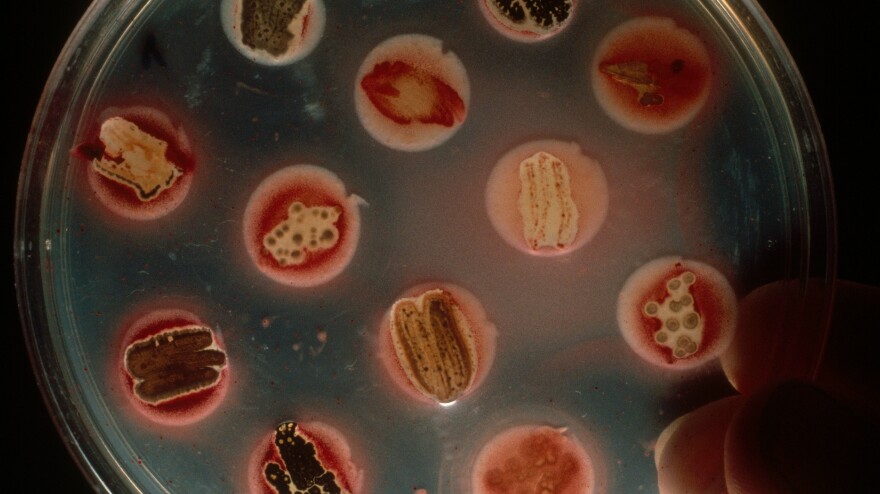Could you dig up the next antibiotic in your backyard? Two scientists would like you and, if they're lucky, millions of other people to give it a try.
The researchers hope that lots of do-it-yourself scientists around the world can come up with the next big idea for much-needed drugs.
There are plenty of precedents. Many blockbuster antibiotics were found in soil, where many bacteria produce chemicals to keep rivals out of their territory.
Terramycin, for instance, an old antibiotic from Pfizer, was developed from bacteria found in the soil outside a company factory in Terre Haute, Ind. Vancomycin, an Eli Lilly drug, has its roots in a soil sample from Borneo. Streptomycin, the first antibiotic used successfully against tuberculosis, also came from bacteria found in dirt. The discovery helped Rutgers' Selman Waksman win a Nobel Prize in 1952.
The Centers for Disease Control and Prevention estimates that in the U.S., at least 2 million people get infected with antibiotic-resistant bacteria each year, and at least 23,000 die.
As soon as doctors start prescribing an antibiotic, the germs fight back by evolving to become resistant. Agricultural use also contributes to the problem.
The world needs new antibiotics soon because so many of the existing drugs are losing their punch. Some people are already talking about a "post-antibiotic era," when bacteria can defeat all the drugs doctors have at their disposal.
But drug companies don't spend as much money looking for antibiotics as other types of medicines, such as cancer drugs.
"This is the one therapeutic area where when we design a brand new antibiotic, what will happen is the world will say, 'Thank you very much, that's a great contribution to human medicine, but I'm going to put it on the shelf and only use it when I really have to use it,' " says David Payne, a vice president overseeing antibacterial drug discovery at GlaxoSmithKline.
He says that although this is how doctors should use new antibiotics, it's not a good way to make money.
The federal government is now pitching in. Earlier this year Glaxo and the U.S. Department of Health and Human Services agreed to work on new antibiotics. And the government could pay Glaxo as much as $200 million over the next five years, if things go well.
But crowdsourcing is another option. Josiah Zayner, who's about to take a job doing synthetic biology research at NASA, and Mark Opal, a postdoctoral researcher at the University of Chicago, want to make the drug discovery process easier.
They recently launched a crowdfunding campaign to send out simple test kits, so people can check plants, chemicals and other substances around them for substances that kill bacteria.
The kit would include test bacteria that don't cause disease, so there's something safe for do-it-yourselfers to experiment with. The kits, which would cost between $42 and $102 depending on the version people select, would include all the equipment necessary for amateur antibiotic hunters. Zayner and Opal plan to put the results in an online database, so others can independently verify discoveries.
"You look out your window and you see a tree and you think, 'Oh, I bet you somebody's looked at that tree bark and tried to see if there's some drug or antibiotic compound in there,' " says Opal, who also worked on drug development at the National Institutes of Health. "In reality, in most cases this is not the truth."
They say the more people working on the problem, the better. Having what seems like too much data or having people test the same plants would be good signs, says Zayner.
He points to the Human Genome Project. "When they first sequenced the human genome, they were like, "Oh my gosh I have so much data, what am I going to do with this?' " Zayner says. "A database like (the one they are trying to start), if it succeeds massively, would just be amazing not only for now but for the future, for scientists to look at, for people to look at, just to help us understand what compounds are in plants, insects and other organisms."
But, this massive crowdsourcing effort probably won't find the next antibiotic, says Dr. Brad Spellberg, an associate medical director at the Harbor-UCLA Medical Center and co-author of a recent journal article on antibiotic resistance.
"Over the course of a half-century, pharma pretty much dug in every soil they can get their hands on," Spellberg says. Drug companies have chemical libraries with millions of compounds, he says. If something is easy to find, they probably have it.
Glaxo's Payne agrees, and he wrote a journal article about his company's efforts to identify new drugs based on what's in their libraries. They didn't find much.
Spellberg says it's better to go to places that haven't been explored before, like the bottom of the ocean. He also points out that just because a substance kills bacteria it's not necessarily a good antibiotic. Drugs must be safe, and they have to be relatively easy to take.
Although this project may not uncover the next antibiotic, there may be another benefit, says Gregory Daniel, a fellow at the Engelberg Center for Health Care Reform at the Brookings Institution. It's likely to get more people interested in antibiotic resistance.
"This isn't just talk," Daniel says. "This is actually engaging people into taking part in a potential solution. Advocacy organizations for antibiotics are really hard to come by."
Advocacy can lead to real changes, he says, citing HIV/AIDs as an example. Starting in the 1980s, HIV/AIDS patient advocates pushed for regulatory changes that sped up access to drugs and included activists and patients on advisory boards.
Campaign creators Zayner and Opal say even if they can't meet their fundraising goal, they have already heard from schools interested in using the kits as classroom tools.
Copyright 2021 NPR. To see more, visit https://www.npr.org.





